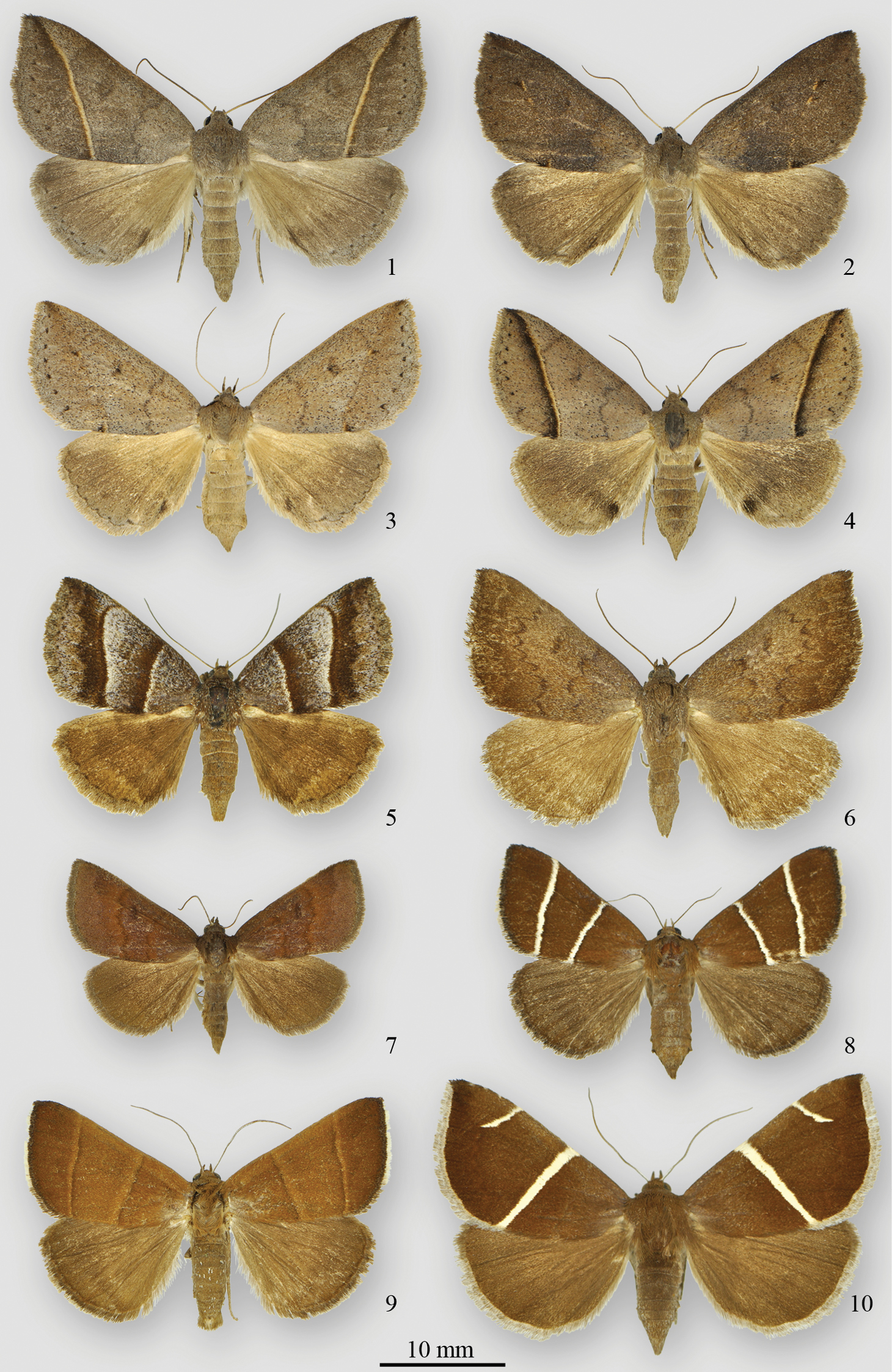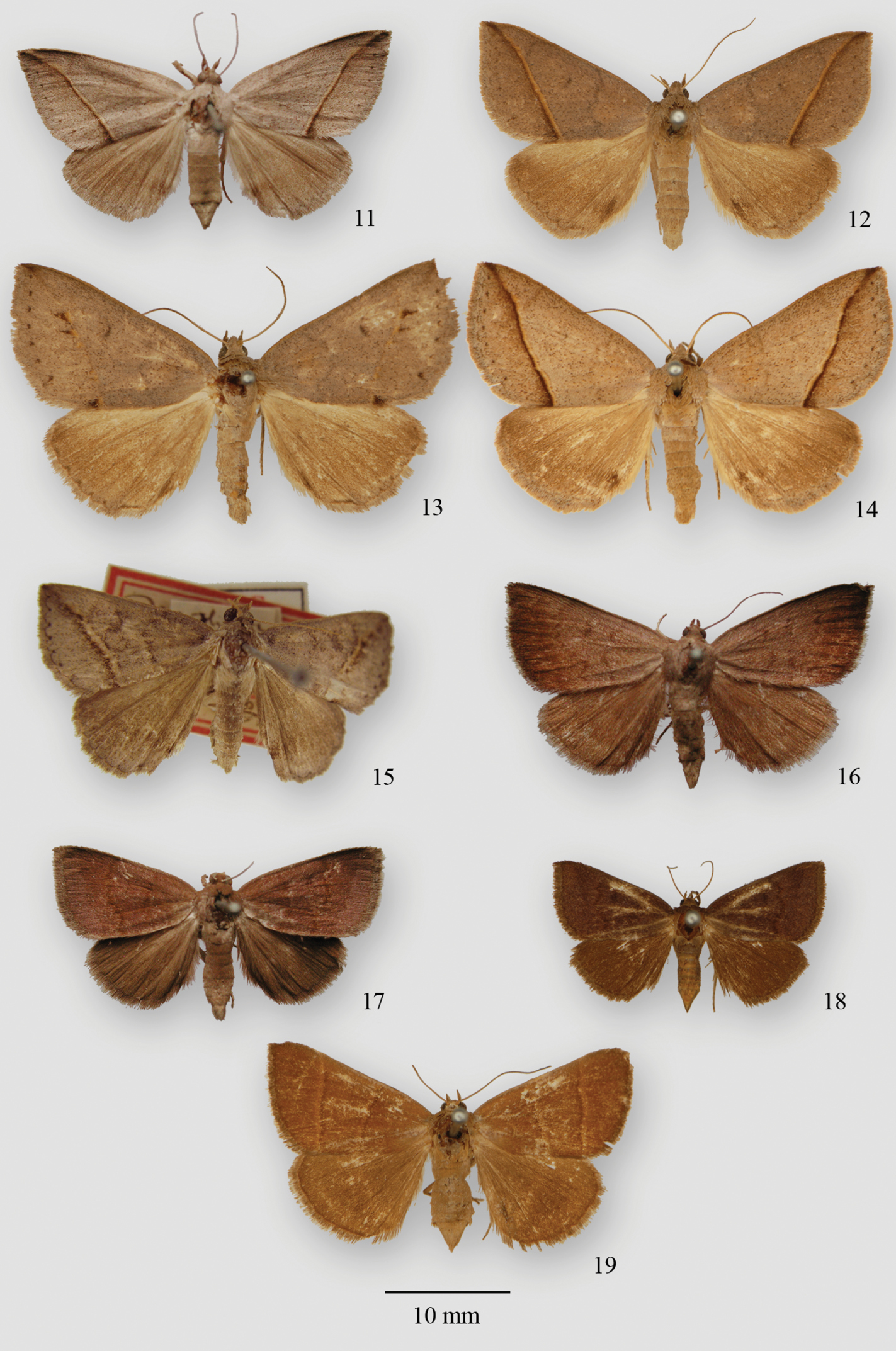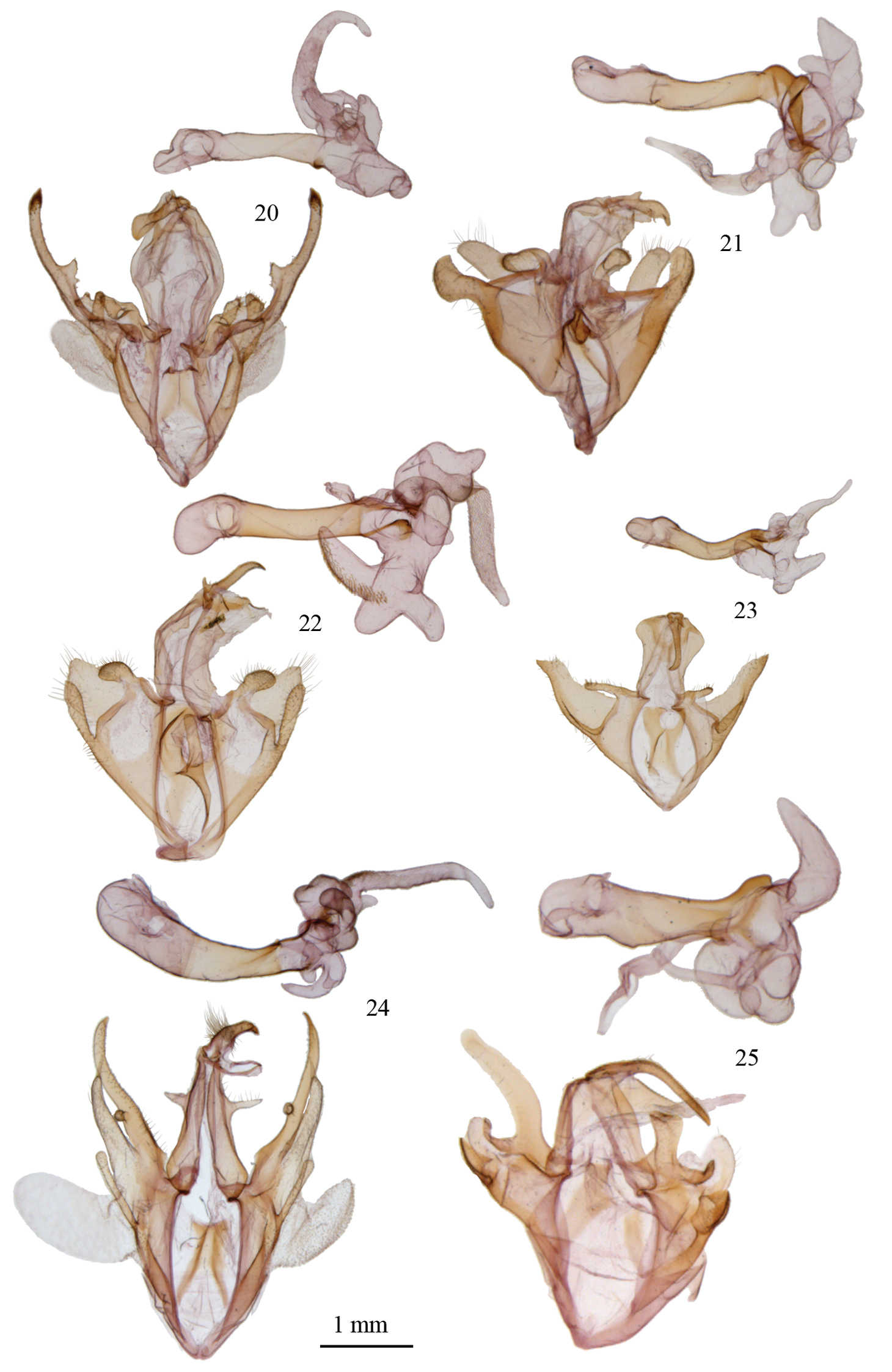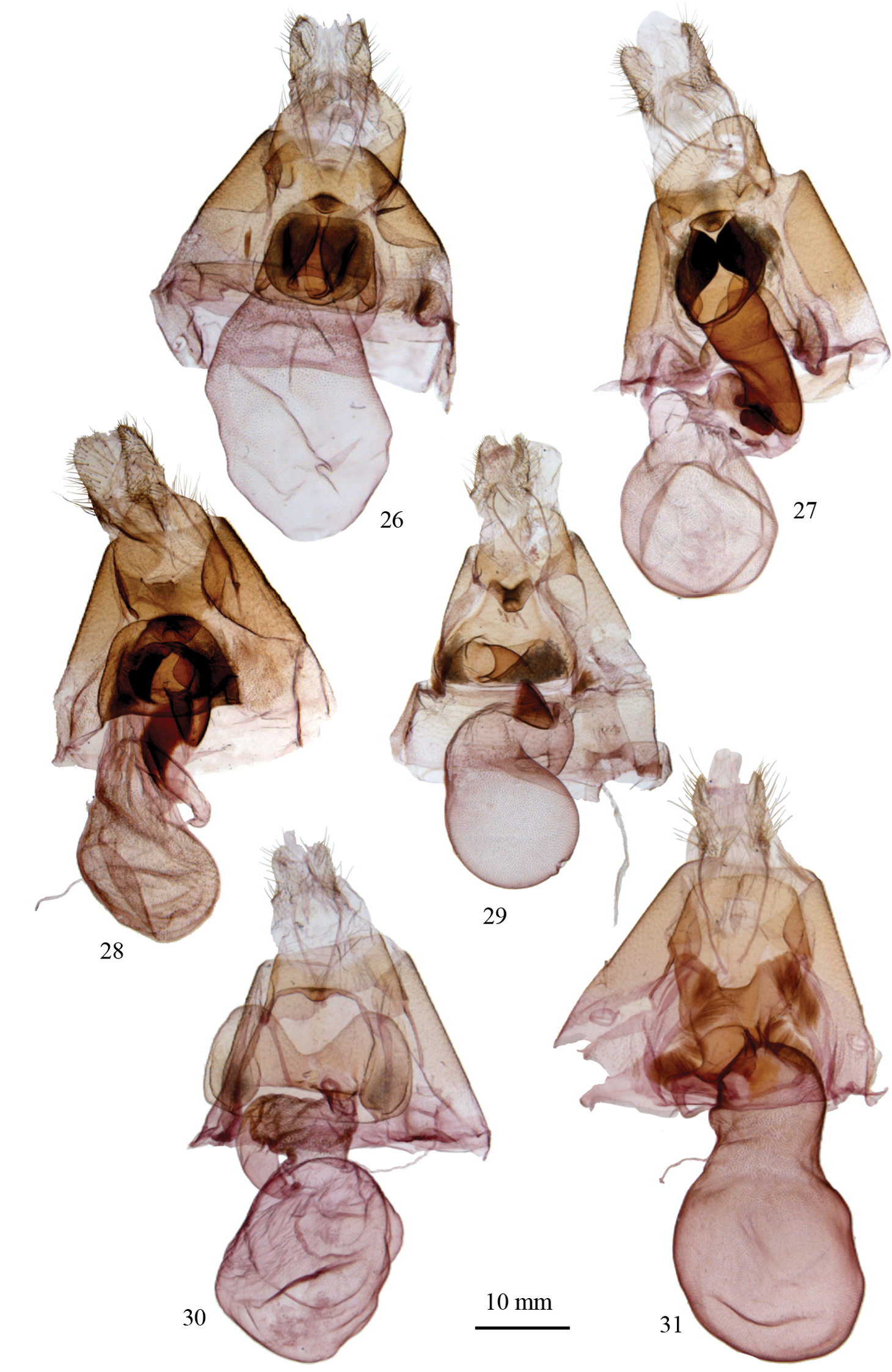






(C) 2011 J. Bolling Sullivan. This is an open access article distributed under the terms of the Creative Commons Attribution License, which permits unrestricted use, distribution, and reproduction in any medium, provided the original author and source are credited.
For reference, use of the paginated PDF or printed version of this article is recommended.
After examining the type specimens of species in the eastern North American genus Argyrostrotis the number of known species in the genus is reduced from 10 to six through synonymy. A key to species is included along with illustrations of the adults and genitalia of each species. Three Neotropical species currently included in Argyrostrotis (Argyrostrotis eurysaces Schaus, 1914; Argyrostrotis quadrata Dognin, 1910; and Celiptera surrufula Dyar, 1913) are transferred to other genera as Argyrosticta eurysaces (Schaus, 1914), comb. n. [Noctuidae: Bagisarinae], Heterochroma quadrata (Dognin, 1910), comb. n. [Noctuidae: Amphipyrinae], and Ptichodis surrufula (Dyar, 1913), comb. n. [Erebidae: Erebinae: Euclidiini].
Argyrostrotis, Argyrosticta eurysaces, Ptichodis surrufula, Heterochroma quadrata, eastern North America
Currently, there are 10 species of Argyrostrotis Hübner listed by
Specimens were examined from the following collections:
AMNH American Museum of Natural History, New York, New York, USA
BMNH The Natural History Museum (statutorily, British Museum (Natural History)), London, UK
CNC Canadian National Collection of Insects, Arachnids, and Nematodes, Ottawa, Ontario, Canada
JBS Personal collection of J. Bolling Sullivan, Beaufort, North Carolina, USA
MNHN Muséum national d’histoire naturelle, Paris, France
USNM National Museum of Natural History (formerly, United States National Museum), Washington, District of Columbia, USA
Dissecting methods and terminologyDissection of genitalia and terms for genital structures and wing markings follow
| 1 | Forewing with postmedial line straight or evenly curved, usually prominent | 2 |
| – | Forewing with postmedial line dentate, usually obscure | 5 |
| 2 | Forewing with postmedial line appearing to extend to apex and usually highlighted by yellow line or spots | Argyrostrotis flavistriaria |
| – | Forewing with postmedial line subapical and without yellow shading | 3 |
| 3 | Forewing with postmedial line curved toward wing base at costa; basal, medial, and terminal areas may be extensively dusted with white scales | Argyrostrotis sylvarum |
| – | Forewing with postmedial line straight; ground color brown | 4 |
| 4 | Postmedial line complete | Argyrostrotis quadrifilaris |
| – | Postmedial line incomplete | Argyrostrotis anilis |
| 5 | Forewing length 15–17mm; fringe with white scaling | Argyrostrotis erasa |
| – | Forewing length 10–13 mm; fringe rarely with white scaling and if so, scaling minute | Argyrostrotis deleta |
http://species-id.net/wiki/Argyrostrotis_flavistriaria
Figs 1–4, 11–15, 20, 26The type material of Crochiphora flavistriaria is lost, but the illustrations (Hübner, 1831, pl. [96], figs 555, 556) are diagnostic and represent the form shown in Fig. 1. The type specimens of Poaphila herbicola and Poaphila contempta are lost, but the original descriptions are diagnostic and represent the forms shown in Figs 2 and 3 respectively. The female lectotype of Poaphila perplexa in the MNHN labelled “Javana [Savannah] Georgia/ perplexa/ Type/ Museum Paris/ Poaphila perplexa Gn. Vol. 7, 1852, p. 302, n=1755” is shown in Fig. 11. The male holotype of Poaphila perspicua in the BMNH labelled “Type/ Argyrostrotis perspicua.” is shown in Fig. 12 and represents the same form as the original illustration of Crochiphora flavistriaria. The male holotype of Mocis? diffundens in the BMNH labelled “Type/ 8. Mocis? diffundens.” is shown in Fig. 13. A male syntype of Phurys glans in the BMNH labelled “Type/ Grote Coll. 82-54./ 3129/ Phurys glans Grote type” is shown in Fig. 14. The male lectotype of Phurys carolina in the AMNH labelled “Phurys carolina Smith % type/ Nth Car., August”/ Coll. J.B. Smith/ Lectotype by E.L. Todd” is shown in Fig. 15.
North Carolina south to Florida and Texas.
http://species-id.net/wiki/Argyrostrotis_sylvarum
Figs 5, 21, 27The type material of Poaphila sylvarum is lost but the original description and associated illustration are diagnostic.
Virginia south to Florida and Texas.
http://species-id.net/wiki/Argyrostrotis_erasa
Figs 6, 16, 22, 28The female lectotype of Poaphila erasa labelled “Javana [Savannah] Georgia/ Poaphila erasa Gn./ Type/ Poaphila erasa Gn. Vol. 7, 1852 p. 301, n=1751” in the MNHN is shown in Fig. 16 [forewing length 17 mm].
North Carolina south to Florida and Texas.
http://species-id.net/wiki/Argyrostrotis_deleta
Figs 7, 17, 18, 23, 29The male lectotype of Poaphila deleta labelled “Javana [Savannah] Georgia/ Poaphila deleta/ Type/ Poaphila deleta Gn. Vol. 7, 1852, p. 300, n=1748” in the MNHN is shown in Fig. 17 [forewing length 13 mm]. A female syntype of Poaphila placata in the BMNH labelled “Georgia, Grote Coll. 82–54./ Poaphila placata Grote Type” is shown in Fig. 18.
Virginia south to Florida and Texas.
http://species-id.net/wiki/Argyrostrotis_quadrifilaris
Figs 8, 9, 19, 24, 30The type specimen of Agronomia quadrifilaris is lost, but the illustrations (Hübner, 1831, pl. [98], figs 569, 570) are diagnostic and represent the form shown in Fig. 8. A female syntype of Poaphila obsoleta in the BMNH labelled “Enterprise, Florida, 12.V. Grote Coll. 82-54./ Poaphila obsoleta Grote Type” is shown in Fig. 19.
New York and New Hampshire south to Florida and Texas.
http://species-id.net/wiki/Argyrostrotis_anilis
Fig. 10, 25, 31 The type specimen of Phalaena anilis is lost, but the illustration in
Southern Canada (Quebec to Saskatchewan) south to Florida and Texas.
Excluded speciesThree species included in Argyrostrotis by
Argyrostrotis eurysaces Schaus, 1914 is hereby transferred to the genus Argyrosticta Hübner, [1821] as Argyrosticta eurysaces (Schaus, 1914), comb. n. [Noctuidae: Bagisarinae]. The two genera are not closely related and the association was more likely an error in confusing the two similar generic names by Schaus than an intended placement in Argyrostrotis.
Argyrostrotis quadrata Dognin, 1910 is hereby transferred to the genus Heterochroma Guenée as Heterochroma quadrata (Dognin, 1910), comb. n. [Noctuidae: Amphipyrinae].
Celiptera surrufula Dyar, 1913, included in Argyrostrotis by
Argyrostrotis adults 1–4 Argyrostrotis flavistriaria 5 Argyrostrotis sylvarum 6 Argyrostrotis erasa 7 Argyrostrotis deleta 8, 9 Argyrostrotis quadrifilaris 10 Argyrostrotis anilis.
Type material of Argyrostrotis 11 Poaphila perplexa lectotype, MNHN 12 Poaphila perspicua holotype, BMNH 13 Mocis? diffundens holotype, BMNH 14 Phurys glans syntype, BMNH 15 Phurys carolina lectotype, AMNH 16 Poaphila erasa lectotype, MNHN 17 Poaphila deleta lectotype, MNHN 18 Poaphila placata syntype, BMNH 19 Poaphila obsoleta syntype, BMNH.
Male genitalia of Argyrostrotis 20 Argyrostrotis flavistriaria 21 Argyrostrotis sylvarum 22 Argyrostrotis erasa 23 Argyrostrotis deleta 24 Argyrostrotis quadrifilaris 25 Argyrostrotis anilis.
Female genitalia of Argyrostrotis. 26 Argyrostrotis flavistriaria 27 Argyrostrotis sylvarum 28 Argyrostrotis erasa 29 Argyrostrotis deleta 30 Argyrostrotis quadrifilaris 31 Argyrostrotis anilis.
We thank Jérôme Barbut (Muséum national d’histoire naturelle, Paris), Terhune Dickel (Anthony, Florida), Martin Honey (Natural History Museum, London, UK), Jim Miller (formerly AMNH, New York), Michael Pogue (Systematic Entomology Laboratory, National Museum of Natural History, Washington, DC) for access to specimens and data. We thank Jocelyn Gill (CNC, Ottawa, Canada) for assistance with the preparation of the genitalia, photographs, and plates.



